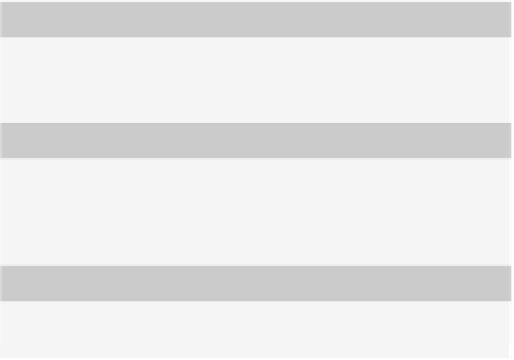Biomedical Engineering Reference
In-Depth Information
treatments have become one of the most important
issues for collagen technology. Two kinds of crosslinking
methods are known for collagen: chemical and physical.
The physical methods that do not introduce any potential
cytotoxic chemical residues include photooxidation, UV
irradiation, and dehydrothermal treatment (DHT).
Chemical methods are applied generally when higher
extents of crosslinking than those provided by the
physical methods are needed. The reagents used in the
chemical crosslinking include glutaraldehyde (GA),
water-soluble carbodiimide (WSC) such as 1-ethyl-
3-(3-dimethylaminopropyl)-carbodiimide (EDAC), hexa-
methylene diisocyanate, acyl azides, glycidyl ethers,
polyepoxidic resins, and so on. A bifunctional reagent
bridging amino groups between two adjacent polypeptide
chains through Schiff base formation, GA, is the most
predominant choice for collagen crosslinking because of
its water solubility, high crosslinking efficiency, and low
cost, although GA is a potentially cytotoxic aldehyde.
Carbodiimides (CDIs) have been widely used for acti-
vation of carboxyl groups of natural polymers under
the acidic conditions that are necessary for protonation of
the CDI nitrogens, leading to nucleophilic attack of the
carboxylate anion at the central carbon to form an initial
O
-acylisourea. The EDAC has been called a ''zero-length
crosslinker'' because it catalyzes the intermolecular for-
mation of peptide bonding in collagen without becoming
incorporated. This crosslinking reaction results in for-
mation of water-soluble urea as only one by-product. If
both unreacted EDAC and urea are thoroughly rinsed
from the material, the concern over the release of toxic
residuals, commonly associated with other chemical
crosslinking agents, will be reduced.
Crosslinking by UVand DHT does not introduce toxic
agents into the material, but both the treatments par-
tially give rise to denaturation of collagen. When collagen
fiber scaffolds for ligament tissue engineering are cross-
linked by DHT, in combination with CDI, approximately
50% of these implants rupture prior to neoligament
formation, due possibly to the collagen denaturation
caused by DHT. Although physical crosslinking can avoid
introducing potential cytotoxic residues, most of the
physical treatments do not yield high enough crosslinking
to meet the demand for collagen as scaffold. Therefore,
chemical treatments are applied in many cases with use
of traditional GA, WSC, and other methods. Such
chemical crosslinking has been shown to reduce bio-
degradation of collagen.
Traditional collagen crosslinking reagents may impart
some degree of cytotoxicity, caused by the presence of
unreacted functional groups or by the release of those
groups during enzymatic degradation of the crosslinked
protein. Furthermore, the chemical reaction that occurs
between amine and/or carboxylic acid groups must be
averted in the case of
in situ
crosslinking of cell-seeded
Table 7.2-2 Medical applications of bioabsorbable polymers
I. For surgical operation
1. Suturing, stapling
2. Adhesion, covering
3. Hemostasis, sealing
II. For implantation
1. Adhesion prevention
2. Bone fixation
3. Augmentation
4. Embolization, stenting
III. For drug delivery
1. Sustained release
2. Drug targeting
cell attachment owing to the presence of cell adhesion
sequence.
Collagens
Collagen is the most abundant protein within the ECM
of connective tissues such as skin, bone, cartilage, and
tendon. At least 20 distinct types of collagen have been
identified. The primary structural collagen in mammalian
tissues is type I collagen (or collagen I). This protein has
been well characterized and is ubiquitous across the animal
and plant kingdom. Collagen contains a large number of
glycine (almost 1 in 3 residues, arranged every third resi-
due), proline and 4-hydroxyproline residues. A typical
structure is -Ala-Gly-Pro-Arg-Gly-Glu-4Hyp-Gly-Pro-.
Collagen is composed of triple helix of protein molecules
which wrap around one another to form a three-stranded
rope structure. The strands are held together by both
hydrogen and covalent bonds, while collagen strands
can self-aggregate to form stable fibers. Collagen is natu-
rally degraded by metalloproteases, specifically collage-
nase, and serine proteases, allowing for its degradation to
be locally controlled by cells present in tissues.
Allogeneic and xenogeneic, type I collagens have been
long recognized as a useful scaffold source with low an-
tigenic potential. Bovine type I collagen has perhaps been
the biological scaffold most widely studied due to its
abundant source and its history of successful use. Type I
collagen is extracted from the bovine or porcine skin,
bone, or tendon through alkaline or enzymatic proce-
dures. Most of the telopeptide portion present at the end
of collagen molecule with antigenic epitopes is removed
during the extraction processes. The low mechanical
stiffness and rapid biodegradation of the extracted but
untreated collagen have been crucial problems that limit
the use of this biomaterial as scaffold. Since crosslinking
is an effective method to improve the biodegradation
rate and the mechanical property of collagen, crosslinking


















